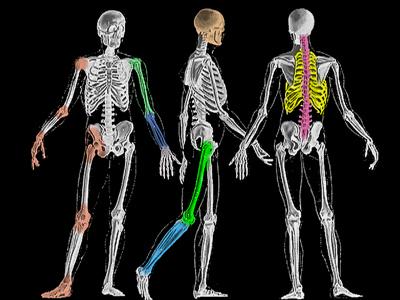 |
|
|
|
|
||||||||||||||||||||||||||
 |
||||||||||||||||||||||||||
|
The Shoulder The shoulder is a region and the shoulder is a joint. As a joint it is made up of more than one bone. There is the wing bone ( alias = scapula) and the humerus.
|
The shoulder blade (or wing bone) is technically called the scapula. It rests against the chest wall which is rounded. From that, (see left image) it does not sit with the shoulder joint pointed laterally (lateral = toward the side) but rather it points a bit forward as seen on the left. An x-ray taken front to back of the body (anterior to posterior, or 'AP') finds the scapula obliquely forward rather than flat on. On the right we see the view perpendicular to the scapula itself. This right shoulder is viewed at an angle to the front of the body. This view shows the joint. The scapula side of the joint is called the glenoid . Sitting in the glenoid is the rounded head of the humerus.
With the humerus removed we see the acromion better. Acromion starts with the letter 'A' while clavicle starts with the letter 'C'. Those are the letter names for
the AC Joint - the joint between the clavicle and the acromion. The AC joint isn't much of an articulation - noting fits into something else. It is an articulation held by ligaments. This is the joint most commonly
"sprung" with a blow to the side of the shoulder area (like trying to bust a door down Hollywood style - Looking from the side, we see the glenoid joint surface better. It isn't much of a socket. It is deepened by a ring of tissue at the edges ( a labrum - like lips). Even so, a cuff of muscles and balanced forces are key in keeping the humeral head in this shallow dish. We see the acromion extending up like a hood from the rear ( at 11 o'clock) and the coracoid protruding forward (at 1 o'clock)
from the top of the glenoid area. The coracoid is the anchor for a biceps accompanying muscle (coraco-brachial) and the lesser pectoral (minor) and one part of the biceps. The space between
the coracoid and acromion is spanned by a tough ligament (nearly like rope) called the coracoid acromial ligament. That ligament and any protrusions of bone at either insertion
may dig (impinge) into the cuff of muscle covering the top of the humerus. It pinches when the arm is raised to the side - the impingement From the back of this right scapula we see that the acromion is an extension of a horizontal-ish ridge. Muscle sits above and below this ridge applied to the flat of the scapula. That muscle converges on the humeral head to form the rotator cuff. At the lower edge of the glenoid, from the back, the triceps tendon attaches. Overlying the scapula and attaching to that prominent ridge (called the scapula spine), the trapezius muscles From the medial edge we better appreciate the curved deep surface designed to ride on the rib cage. The glenoid is pointing away from us. The acromion is to the far right of the image. The coracoid points to the left. A very violent pull on the pectoralis minor with help from a muscle that often gets lumped in with the biceps, though it is it's own muscle, can pull off (avulse) the coracoid. Ouch.
Here the arm is in the stick'em up posture The big bump on top of the humerus which just barely passes below the acromion is the greater tuberosity (another way of saying big bump). To that, attaches the rotator cuff and forward it, the biceps tendon sits in a groove. This is a tight fit and is the place and posture for impingement when it occurs. Putting a hat on can hurt.
_o_
|
|
|
||||||||||||||||||||